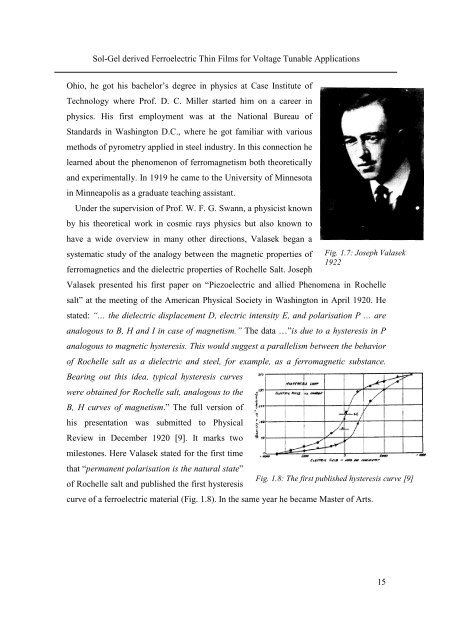PhD Thesis Arne Lüker final version V4 - Cranfield University
PhD Thesis Arne Lüker final version V4 - Cranfield University
PhD Thesis Arne Lüker final version V4 - Cranfield University
Create successful ePaper yourself
Turn your PDF publications into a flip-book with our unique Google optimized e-Paper software.
Sol-Gel derived Ferroelectric Thin Films for Voltage Tunable Applications<br />
Ohio, he got his bachelor’s degree in physics at Case Institute of<br />
Technology where Prof. D. C. Miller started him on a career in<br />
physics. His first employment was at the National Bureau of<br />
Standards in Washington D.C., where he got familiar with various<br />
methods of pyrometry applied in steel industry. In this connection he<br />
learned about the phenomenon of ferromagnetism both theoretically<br />
and experimentally. In 1919 he came to the <strong>University</strong> of Minnesota<br />
in Minneapolis as a graduate teaching assistant.<br />
Under the supervision of Prof. W. F. G. Swann, a physicist known<br />
by his theoretical work in cosmic rays physics but also known to<br />
have a wide overview in many other directions, Valasek began a<br />
systematic study of the analogy between the magnetic properties of<br />
ferromagnetics and the dielectric properties of Rochelle Salt. Joseph<br />
Fig. 1.7: Joseph Valasek<br />
1922<br />
Valasek presented his first paper on “Piezoelectric and allied Phenomena in Rochelle<br />
salt” at the meeting of the American Physical Society in Washington in April 1920. He<br />
stated: “… the dielectric displacement D, electric intensity E, and polarisation P … are<br />
analogous to B, H and I in case of magnetism.” The data …”is due to a hysteresis in P<br />
analogous to magnetic hysteresis. This would suggest a parallelism between the behavior<br />
of Rochelle salt as a dielectric and steel, for example, as a ferromagnetic substance.<br />
Bearing out this idea, typical hysteresis curves<br />
were obtained for Rochelle salt, analogous to the<br />
B, H curves of magnetism.” The full <strong>version</strong> of<br />
his presentation was submitted to Physical<br />
Review in December 1920 [9]. It marks two<br />
milestones. Here Valasek stated for the first time<br />
that “permanent polarisation is the natural state”<br />
of Rochelle salt and published the first hysteresis<br />
Fig. 1.8: The first published hysteresis curve [9]<br />
curve of a ferroelectric material (Fig. 1.8). In the same year he became Master of Arts.<br />
15

















